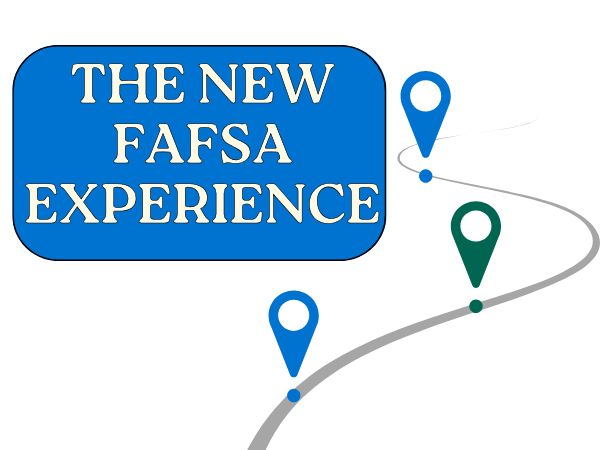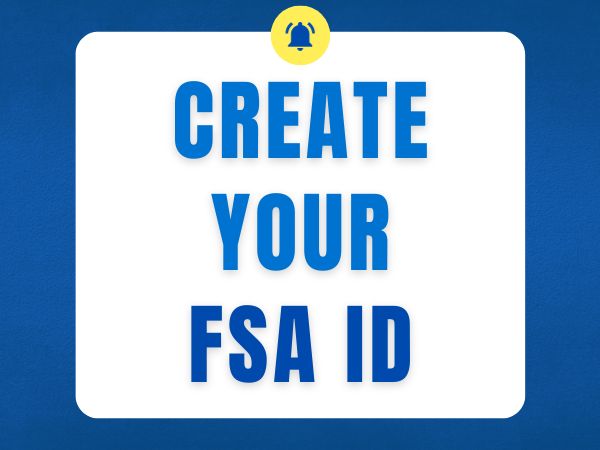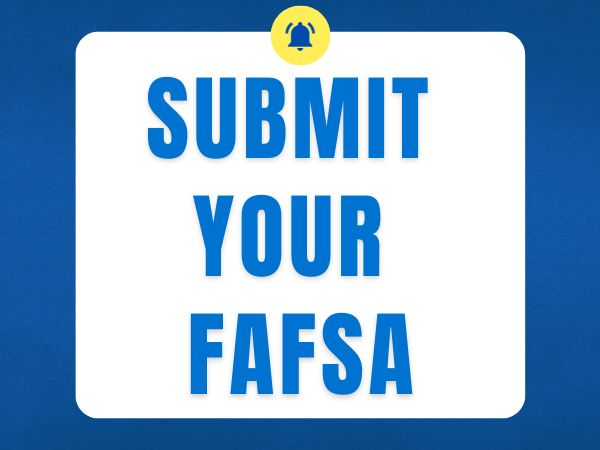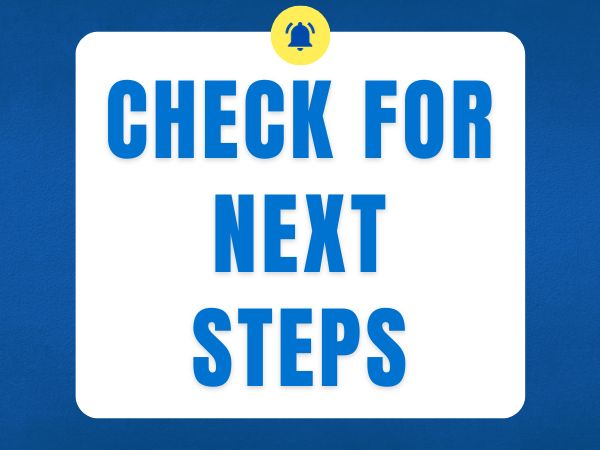FAFSA Simplification

Due to the passing of the FAFSA Simplification Act, the Department of Education is rolling out significant changes to the 2024-2025 FAFSA — marking its first major redesign in over 40 years.
This redesign is intended to make applying for federal student aid easier for students, with fewer questions and fewer requirements to streamline the process.
Please read below to learn about what changes have already occured, what you can still expect, how you can submit your FAFSA, and frequently asked questions.
How to Start
1. Create an FSA ID. All participants must create an FSA ID and wait for it to be verified before being able to complete the FAFSA.
2. Submit your FAFSA. Students should begin their section of the FAFSA first. All other participants will be invited to complete after.
3. Next Steps. Our Student Financial Aid office will begin to import FAFSAs as soon as possible and offer you financial aid.
Summary of Key Changes
The new term contributor has been introduced to the 2024-2025 FAFSA, which refers to anyone who is required to provide information on a student’s FAFSA form.
The new FAFSA is student driven, so that means the student's answers on their section will determine who will be a contributor. Contributors besides the student and parent may now include the student’s spouse or the parent’s spouse (stepparent). Contributors will each log in to the FAFSA separately with their own FSA ID account, to complete each of their specific sections and questions that only they can view.
View the FAQs below to see how the FAFSA will identify which contributors you will need to include.
Students and all contributors must create an FSA account, known as an FSA ID, to complete and sign the online 2024-2025 FAFSA.
The ability to create an FSA ID has historically been limited only to parents who can be verified with a Social Security Number (SSN). However on the 2024-2025 FAFSA, all parent and spouse contributors without a SSN may now create one, using the Department of Education's newly developed system to validate their identity against credit bureau data.
Users with a SSN will need to wait 1-3 days for their FSA account to be verified by the Social Security Administration before starting the FAFSA. Users without a SSN will be verified immediately if their data aligns.
Rather than importing tax information into the FAFSA using the previously used IRS Data Retrieval Tool (DRT), contributors will now consent to transfer their tax information through the IRS Direct Data Exchange (DDX). This will reduce the number of financial questions that most families will see on the FAFSA.
The student and all contributors must provide this consent and approval on the FAFSA in order to be eligible for federal student aid. Providing consent even applies to contributors who don't have a Social Security Number, didn't file 2022 taxes, or who filed taxes outside the US.
The methodology used to measure a families ability to pay for college and their resulting financial aid eligibility, currently known as the Expected Family Contribution (EFC), has been replaced with the Student Aid Index (SAI).
The new SAI formula will result in a new eligibility calculation for Federal Pell Grants and redefine a minimum need determination of SAI to be as low as -1500, in order to better target students with the highest need.
Adjustments to the new Student Aid Index (SAI) calculation and eligibility formulas are estimated to increase the number of Pell Grant recipients by nearly 15%.
Eligibility for federal student aid will also be expanded by removing the questions related to Selective Service registration and drug conviction status, and restoring access to Pell grant for incarcerated students under specific programs.
Homeless, orphan, former foster youth, and unaccompanied youth—as well as applicants who cannot provide parental information because of unusual circumstances—will be able to complete the FAFSA with a provisional independent status determination and receive a calculated Student Aid Index (SAI).
Once the FAFSA is submitted, students can then reach out to the Student Financial Aid office to request that their independent status determination be approved based on supporting documentation. The student will receive an automatic renewal of the independent status (starting in 2025-2026) as long as their circumstances remain unchanged.
The resulting summary of a student's processed FAFSA form is now known as the FAFSA Submission Summary (FSS), with it formerly being called the Student Aid Report (SAR). This summary will become available to the student when they log into their StudentAid.gov account after their FAFSA is sent to the schools requested on the form.
The FSS will, provide students with their calculated Student Aid Index (SAI), provide their official Federal Pell Grant eligibility, indicate whether they are selected for verification, and indicate if any corrections to their FAFSA area required. View a sample FSS.
- All student and parent/spouse contributors are only allowed 45 days of inactivity on any incomplete section of the FAFSA before the FAFSA will be deleted. Once deleted, the FAFSA will need to be restarted by the student.
- Students may now send their FAFSA to up to 20 colleges
- The FAFSA will be expanded to the 11 most common languages spoken by English learner students and their parents
- Language-specific resources and support will also be available from FSA Information Center
- Once the FAFSA has been started, students will now be able to view the status, including contributor progress, on their FSA account
- Once all required data has been provided and all sections have been signed, any contributor can submit the FAFSA form
- After the FAFSA form is processed, a contributor is able to correct or update only their sections of the student’s application
- A demographic data survey will be added to the FAFSA with questions related to race, ethnicity, and gender. The survey will have no effect on federal student aid eligibility and is used only for statistical purposes.
Application Delays
On December 31st, 2023, the Department of Education began its "soft launch" of the newly designed 2024-2025 FAFSA to ensure that all new features were running as intended. This launch occured three months later than its normal release date of October 1st.
NEW: It has just been announced that 2025-2026 FAFSA will have a delayed release date, opening by December 1st, 2024. A possible earlier date will be announced once a testing period has been finalized.
Students and contributors without a Social Security Number have experienced system widespread setbacks in creating and validating their StudentAid.gov account with the Department of Education, resulting in FAFSAs that have not able to be completed and submitted since opening in December 2023.
Starting May 2024, the Department enabled changes to their system that allows applicants and contributors without a SSN to immediately access the online 2024-25 FAFSA form after creating a StudentAid.gov account. While identity validation must still occur on all accounts, the FAFSA may now be completed before that takes place.
The Department of Education announced that all 2024-2025 FAFSA submissions would not be provided to student's selected colleges until the middle of March as they were continuing to finalize all updates to their FAFSA systems.
Due to this delay, our Student Financial Aid office could not confirm that your FAFSA had been received until late April - May. Communications were sent to your personal email once we received your FAFSA.
The Department rolled out the ability to make FAFSA corrections or updates at the end of April 2024. For guidance on how to submit a correction if there was an issue with your original submission, click the link below.
You may check the current status of your FAFSA as determined on your studentaid.gov account by:
- Logging in to StudentAid.gov with your FSA ID.
- Navigating to your account Dashboard.
- Selecting "2024-25 FAFSA Form" from the "My Activity" page. The application status will be one of the following:
You may also view your student ACES account to check for any incomplete requirements once you have submitted your FAFSA.
Contributor is a new term introduced on the 2024-25 FAFSA. It refers to anyone asked to provide information on a FAFSA including:
- the student
- the student's spouse
- the biological or adoptive parent(s)
- the spouse of a remarried parent who is on the FAFSA (stepparent)
The student's answers on their section of the FAFSA will determine which additional contributors (such as parents or spouse) will be required to provide their information. An invitation will go out to these contributors once the following information is entered on the FAFSA:
- Contributors name
- Date of birth
- Social Security number
- Email address
*For any contibutor who was married and filed jointly on their taxes in 2022 and are no longer married to that spouse, or who have married a different spouse, will be required to self-report their tax information instead of using the Direct Data Exchange (DDX). Consent on the FAFSA must still be provided in this circumstance.
- Contributor receives an email informing them that they've been identified as a contributor by the student.
- Contributor creates a FSA account if they don't already have one.
- Contributor logs in to account using their FSA ID account username and password.
- Contributor reviews information about completing their section of the FAFSA form.
- Contributor provides the required personal and financial information on their own sections of the FAFSA form.
Families may create an FSA ID on the Federal Student Aid website anytime before the starting their FAFSA. This applies to all student, parent, or spouse contributors, with or without a Social Security Number (SSN).
Yes. Starting in 2024-2025, parents and spouses who are not U.S. Citizens and are without a Social Security Number (SSN) must now create an Federal Student Aid account.
The process of creating an FSA ID for those without a SSN became available starting in January, using the Department of Education's newly developed system to validate identity against credit bureau data. Contributors will provide their Name, Date of Birth, Mailing Address, Email Address; along with validating several follow up questions. If you answer these questions correctly, you’ll be able to use your account immediately to complete the FAFSA.
No. You can retrieve your existing FSA ID if you forgot your username and password.
An FSA ID created using a Social Security Number (SSN) will take around 1-3 days to be verified and ready to use to complete a FAFSA. We recommend creating it a few days before starting the FAFSA .
An FSA ID created without using a SSN will be immediately verified and is ready to use to complete the FAFSA instantly.
Consent
As a result of the Future Act, all contributors are required to have an FSA ID and provide consent in order to:
- Have their federal tax information (FTI) transferred from the IRS
- Have their tax data used to determine the student's eligibility for aid
- Allow the Department of Education to share their tax information with institutions and state higher education agencies for the administration of Title IV aid.
Consent is provided once for the award year and cannot be revoked in that award year. This consent is necessary even if the contributor does not have an SSN, did not file taxes, or filed taxes in another country.
If a required contributor does not provide consent to have their tax information transferred to the FAFSA form, the Student Aid Index (SAI) will not be calculated and the student will not be eligible for federal student aid.
Note: Being a contributor does not implicate financial responsibility for a student's education.
If any contributor does not provide consent on the FAFSA, the student will not be eligible for any Title IV aid.
Students will be given the opportunity on the FAFSA to indicate they would like to receive a Direct Unsubsidized Loan in these situations. Please be advised that at the Alamo Colleges, students must submit a Direct Unsubsidized Loan request on their ACES account if they are interested in taking out a loan.
Once an electronic FAFSA is started online, all contributors must complete it online. That means that if a electronic signature was left missing, the contributor that needs to sign the application must log in again with their FSA ID.
If a student chooses to complete a paper form, all contributors will need to provide consent, wet (physical) signatures, and mail the application to the Department of Education address listed on the paper application. This method is not recommended due to complexity and increased processing time.
Tax Information
2022 tax information and earnings will be reported on the 2024-2025 FAFSA. Learn more about what documents you will want to have on hand to complete your FAFSA accurately by watching the video below.
Family size reported on the FAFSA will be automatically calculated based on the number of individuals claimed on the tax return (if filed). If your family size on the FAFSA needs to be reported differently than the number claimed on your taxes, there will be an option to correct the number manually after consent has been provided.
Note: A contributor cannot see what family size was reported from the IRS as that information is protected - be sure to have a copy of your tax return on hand to check who was claimed.
There are a several instances where the application will allow you to self-report if federal tax information cannot be accurately transferred through the Direct Data Exchange (DDX). Examples of when self-reporting is necessary:
- Individuals who were married and filed jointly with the IRS in 2022 and are no longer married to that spouse, or who have married a different spouse
- Individuals with foreign income or who only file foreign tax returns, as the IRS does not link to foreign tax authorities. They will instead need to manually input their income and tax data by converting foreign currency to U.S. dollars and entering the resulting amounts in the comparable fields from U.S. tax returns, such as adjusted gross income, income tax paid, and any untaxed income.
- The contributor is a victim of IRS tax-related identity theft
- The contributor indicates on the online FAFSA that they have not filed a tax return but plan to.
While manually entering tax information into the FAFSA is allowable in these and several other situations, consent must still be provided.
The Data Retrieval Tool (used on the 2023-2024 FAFSA) is an optional tool to transfer your tax information on to the FAFSA, while consent to transfer tax information using the Direct Data Exchange (on the 2024-2025 FAFSA) is required for eligibility.
The Direct Data Exchange uses an improved process to automatically match a participant with the IRS, meaning a participant will no longer be directed to go on to the IRS website to enter their exact mailing address from their tax return to get a match before data is transferred.
SAI & Pell
Yes, students and counselors may utilize the Federal Student Aid Estimator to find out how much federal student aid a student may be eligible for starting with the 2024–2025 award year based on an estimated Student Aid Index (SAI).
The Maximum Pell Grant award for the 2024-2025 aid year is unchanged at $7,395.
The Scheduled Pell Award is the calculated award amount a student can receive during an academic year if they attend full-time (12 hours). Beginning with the 2024-2025 FAFSA, this award is calculated in three ways.
- Maximum Pell Grant - Automatically calculated when a student has a Student Aid Index (SAI) between –1500 and 0.
- Student Aid Index (SAI) Calculation - Used for students who don’t automatically qualify for a Maximum Pell Grant, but have a calculated SAI that is less than the Maximum Pell Grant award for the award year. Calculation: The Maximum Pell Grant for the award year minus (-) the student's SAI = the student’s Scheduled Pell award.
- Minimum Pell Grant - Students whose calculated SAI is greater than the Maximum Pell Grant award for the award year may still be eligible for a Pell Grant based on family size, adjusted gross income, and poverty guidelines.
The new Student Aid Index (SAI) includes several changes in the calculation used to determine aid:
- The number of family members in college is no longer considered in the calculation, but it remains a required question on the form
- Child support received will now count as an asset
- Family farms and small businesses will now count as assets - with the net worth of businesses and farms of any size included
- Families with an Adjusted Gross Income (AGI) greater than $60,000 will be required to report asset information
Impacted Populations
FAFSA Simplification changes will not result in significant changes to the 2024-2025 TASFA application experience except for the following:
- The methodology used by the federal and state government to measure a families ability to pay for college and their resulting financial aid amount, currently known as the Expected Family Contribution (EFC), has been replaced with the Student Aid Index (SAI).
- To calculate the Student Aid Index (SAI) and better align with the FAFSA, 11 questions have been added and 20 have been removed from the TASFA.
This transition away from using the EFC to using the SAI has not been announced to have any impact on how much state financial aid a TASFA student is eligible to receive at the college they choose to attend.
Questions?
Call the FAFSA Helpline provided by Trellis, a trusted Alamo Colleges District partner, at 1-877-845-9883. This FAFSA Helpline is available Monday - Thursday: 8 am to 6 pm and Friday: 8 am to 5 pm.
If you need further assistance, please contact our Student Financial Aid Office at 210-21ALAMO (210-212-5266).
Financial Aid Timeline
| Dates | Event |
|
December 31st 2023
|
The revised Free Application for Federal Student Aid (FAFSA) for the 2024-2025 year became available for students and families to complete. This release allows all parent and spouse contributors, with or without a Social Security Number (SSN), to now create an FSA ID and fill out the form. |
|
January - May 2024
|
Our Student Financial Aid office offered hands-on-help to complete the FAFSA or TASFA at our Financial Aid Saturday events. |
|
April - May 2024
|
Our Student Financial Aid Office began to receive student's FAFSA submissions from the Department of Education. Confirmations were sent to the student's personal email once we received it. |
|
Late April 2024 |
Corrections to the FAFSA became available for students or contributors to complete. If an error was made on the FAFSA, student's may initiate a correction process on studentaid.gov. |
|
Late May - June 2024
|
Our Student Financial Aid Office will began to process your FAFSA information, update your ACES account with any outstanding requirements, and create your financial aid award offers. |
|
June - July 2024 |
Virtual financial aid help sessions were offered every Monday in June-July. |









